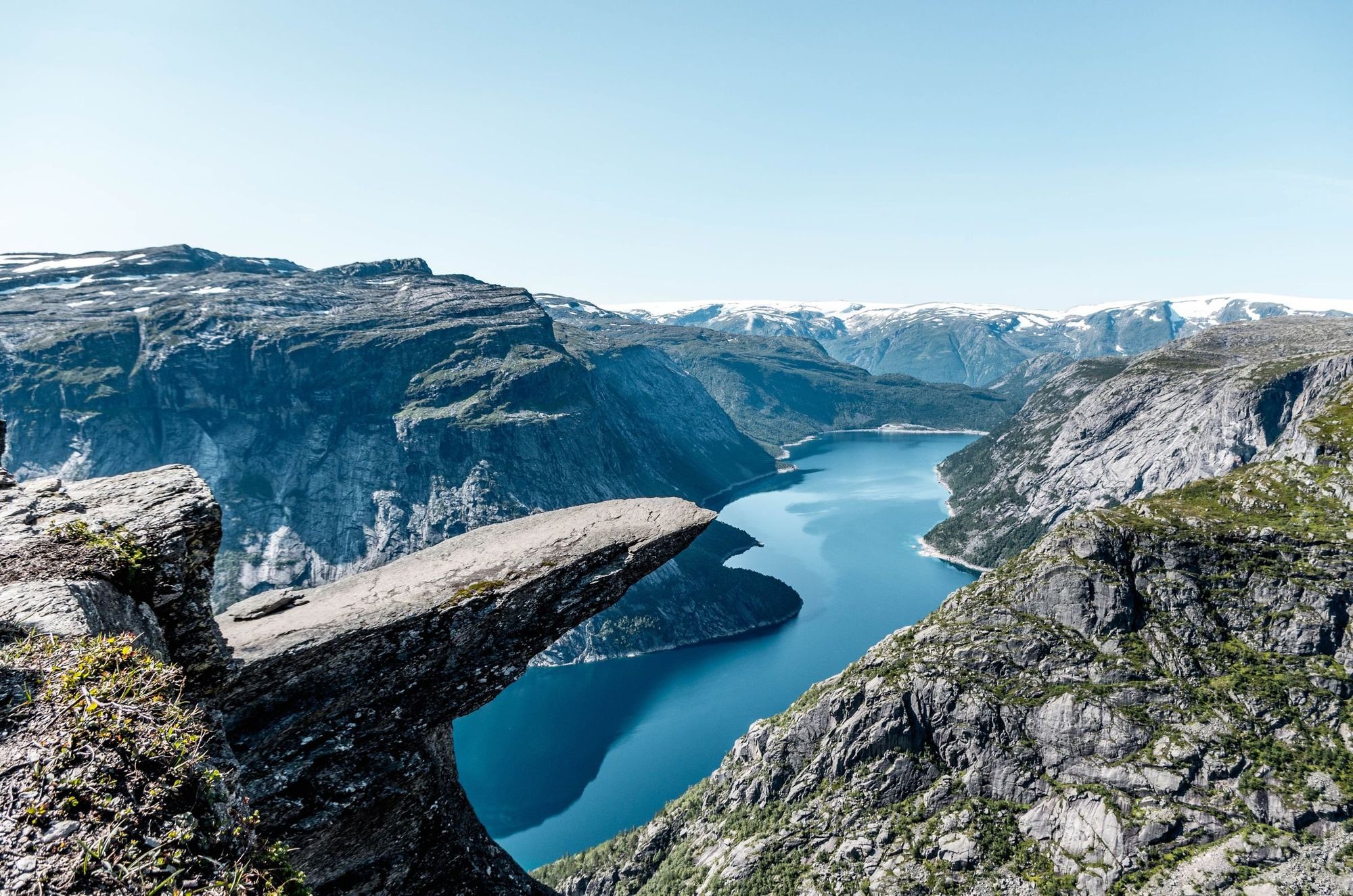Trolltunga, meaning "Troll's Tongue," is one of Norway's most iconic rock formations. It’s a ‘tongue’ of rock jutting out over Ringedalsvatnet Lake, a glacial body of water surrounded by high rocky cliffs.
According to legend, one night a curious troll wandered to the edge of the cliff to admire the beautiful view of the fjords and mountains below. Lost in the scenery, the troll didn’t notice the rising sun. As the first rays of sunlight hit him, he turned to stone - a common fate of trolls featured in Scandinavian mythology. His tongue, which had been sticking out, became the iconic Trolltunga rock we see today.

Trolltunga is one of the most photographed locations in Norway. In peak season, you might even have to queue up to grab that shot for the 'gram - the one of you posing on the gravity-defying rock, surrounded by rocky cliffs and mountains, with the icy Folgefonna Glacier in the background.
But hiking Trolltunga is more than just about posing for the perfect photo. Covering 16.7 miles (27km) out-and-back, it’s a challenging all day affair taking you through the heart of the Norwegian wilderness. You’ll hike up through rocky boulder fields, over meltwater streams and across the Hardangervidda plateau, surrounded by snow-capped mountains.
In this guide, we take a closer look at the Trolltunga hiking route, examine the best time of year to visit and answer some FAQs around accommodation and logistics.
Where is Trolltunga?
Trolltunga is located approximately 700m (2,296ft) above Ringedalsvatnet Lake in Norway's Vestland county. It's located on the western edge of the Hardangervidda plateau, near the town of Odda.
Hiking Trolltunga: the Route
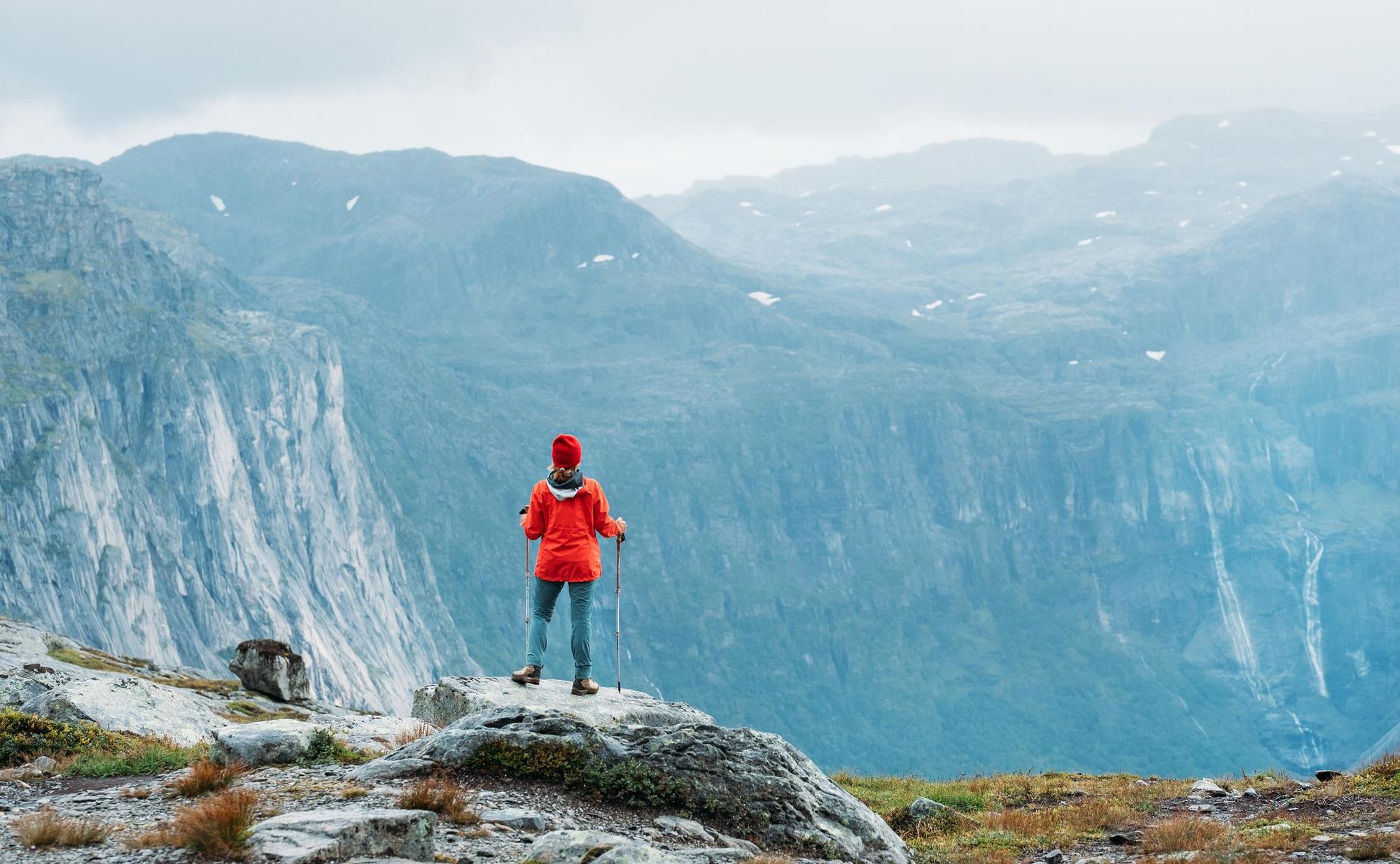
- Start/Finish: P2 Skjeggedal (out and back)
- Distance: 16.7 miles (27km)
- Walking time: 10-12 hours
- Difficulty: Challenging
- Best for: the most iconic view in Norway
The Trolltunga hike might be popular, but it really isn’t a walk in the park. In fact, it’s a full day trek with around 800m (2,624ft) of ascent. Expect steep climbs, rugged terrain, and unpredictable mountain weather. However, you’ll be more than rewarded by the sweeping mountain and fjord views as you climb.
The hike begins at the P2 Skjeggedal car park. If you're starting here, you’ll have an initial climb up a narrow paved road leading to the higher car park at P3 Mågelitopp. This section takes about an hour to walk and gains over 400m in elevation. It is possible to skip this section and save some time, although parking at Mågelitopp is extremely limited and needs to be pre-booked.

From P3, the true trailhead of the Trolltunga hike begins. The first section of the trail takes you up a gentle slope through a lush valley, surrounded by rugged peaks. The trail quickly becomes more challenging as it climbs steeply toward Gryteskaret Pass, one of the most difficult sections of the route. The rocky path here can be slippery, especially after rain, so take care with your footing. This strenuous ascent rewards hikers with the first glimpses of the vast wilderness ahead.
After the effort of Gryteskaret, you’ll reach the Trombeskar Pass, where the terrain briefly levels out before dropping into a grassy valley. This section offers a slight reprieve from the uphill climb, with gentler walking and views of the surrounding mountains. The trail hugs the shoreline of a small, serene lake, providing an ideal spot for a short break or snack. In summer, the vivid greenery contrasts sharply with the rocky terrain and often snow-covered peaks, while in the shoulder seasons, the landscape takes on a more muted, rugged beauty.
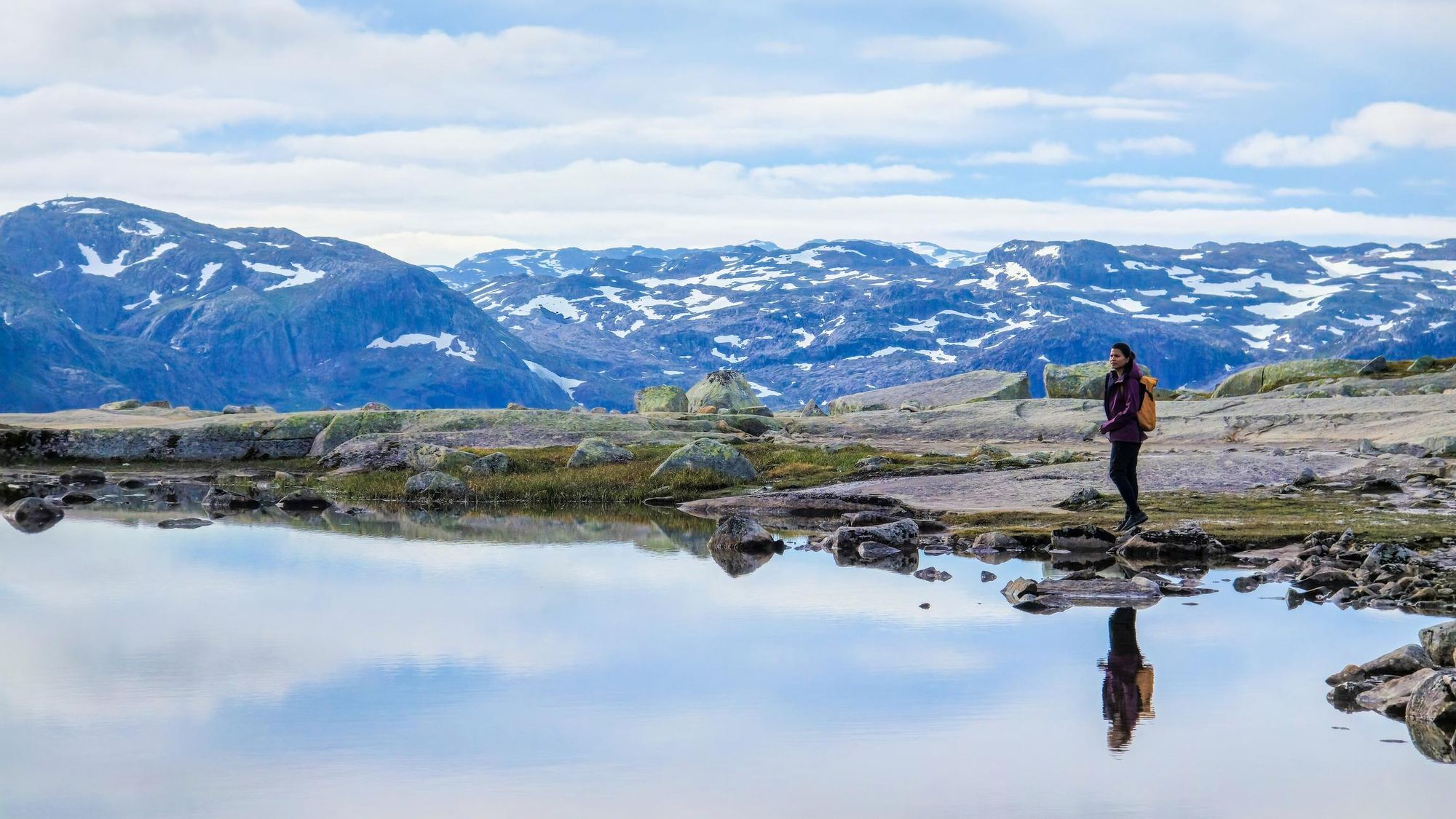
After the lake, the trail gradually ascends across a vast, open plateau - Hardangervidda - with wide, sweeping views of the majestic Ringedalsvatnet lake far below. The plateau is often covered in snow well into the summer months, and meltwater streams crisscross the trail. Wooden bridges have been built over the larger streams, but be prepared for some wet patches and small stream crossings, especially early in the season.
As you approach the final section of the hike, the trail becomes rocky again, with a steady climb toward Trolltunga over boulders and rocks. You may encounter patches of snow depending on the time of year. Along the way, you’ll pass a hydroelectric dam.
Not long after, Trolltunga itself comes into view—a dramatic rock formation that juts out horizontally above the turquoise waters of Ringedalsvatnet, nearly 700m (2,296ft) below. The panoramic view stretches out over the vast fjord, with jagged peaks framing the water below.
The return journey follows the same route back to P2 Skjeggedal. Make sure to leave enough time to return safely before dark, as the trail is not lit, and navigating in low light can be difficult. Carry a headlamp if you're starting early or expect to finish late.
How Hard is the Trolltunga Hike?
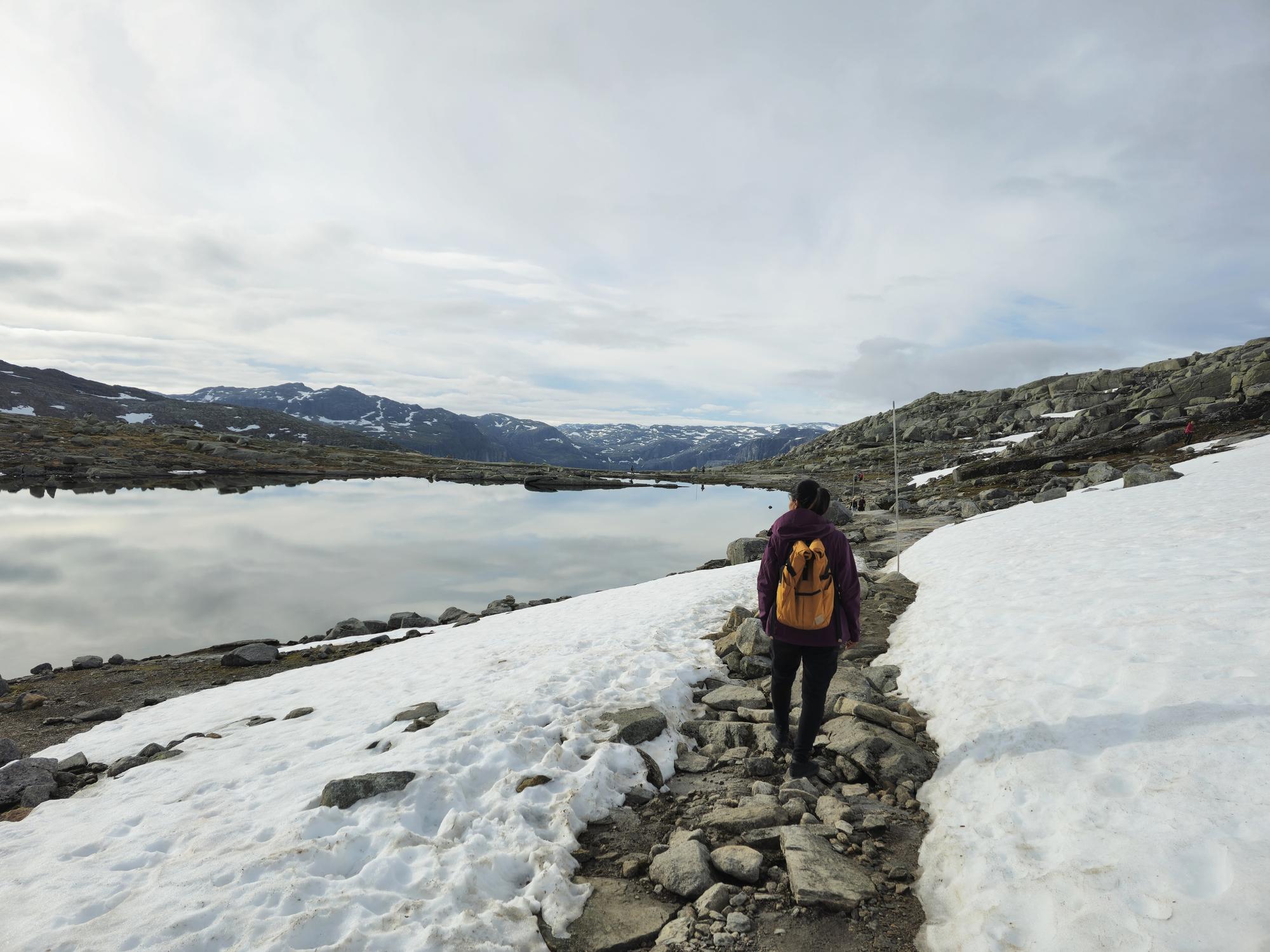
We’d class the Trolltunga hike as challenging, due to its length (16.7 miles/27km) and elevation gain (800m/2,624ft). When it rains, the rocks can become slippery and the path muddy, making hiking more difficult. However, the trail is well-marked—even when you lose the path, look out for red ‘T’s painted on rocks —and anyone with a good level of fitness will be able to complete the hike.
Hiking to Trolltunga in winter is even more difficult. Snowy trails, ice-covered rocks and adverse weather conditions all contribute to this. Most people hiking Trolltunga in winter tend to start from the upper car park at Mågelitopp in order to shorten their ascent - even with this, the hike will likely take longer than during the summer months.
When is the Best Time of Year to Hike Trolltunga?
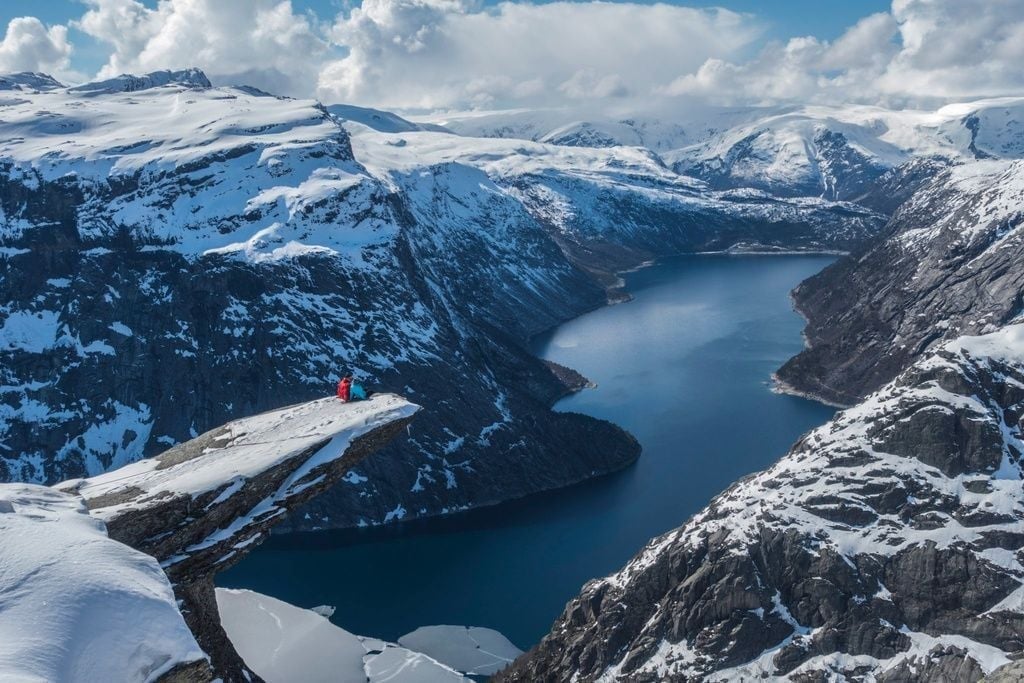
Peak hiking season for Trolltunga runs from June to August, when the snow has melted and the weather is relatively stable (although you can get rain year-round). July is considered the best month for weather, with temperatures on the summit ranging from 9°C to 13°C. During the summer, the trail is well-marked and maintained, and the daylight hours are long, allowing plenty of time to complete the hike.
During the autumn months, the temperatures slowly drop and precipitation increases. However, you will be treated to beautiful displays of autumn foliage and the summer crowds will have dissipated. If you hike Trolltunga in September, temperatures are between 5°C and 9°C. Spring is similar to autumn - cooler and quieter than summer. It’s important to note that you may still experience snow and ice on the trail between March and May.
During the winter months from December to February, there’s very little daylight and the trail is carpeted in snow. Temperatures on the summit can plummet as low as -9°C. However, we think Trolltunga is one of the best winter hikes in Norway - the views from the top are even more spectacular when the surrounding mountains are dusted in snow. We would always recommend going with a guide, as their expert local knowledge will help you navigate the frozen landscape.
How to Beat the Trolltunga Crowds
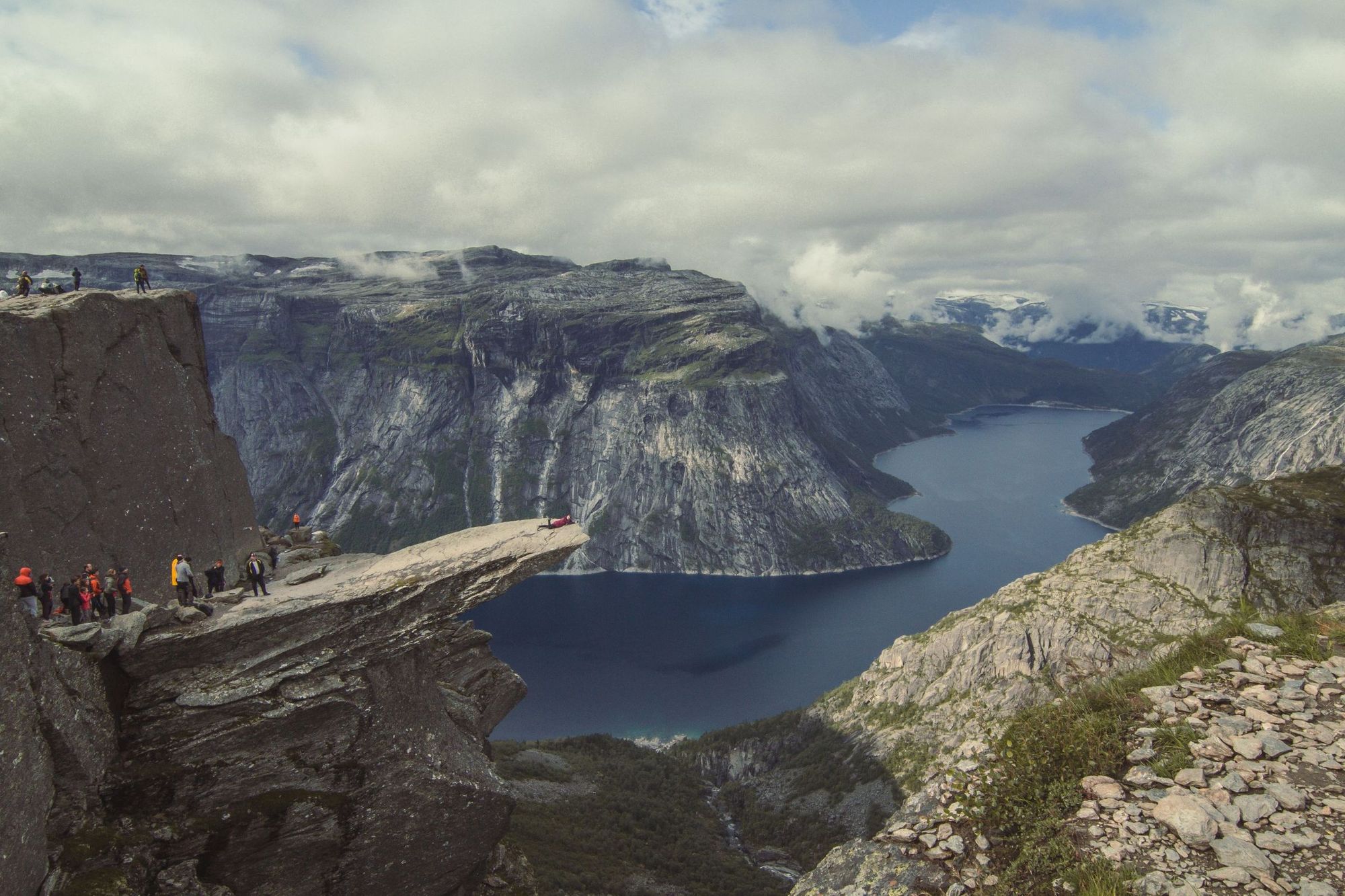
Around 80,000 people hike to Trolltunga each year. Compared to peaks like Yr Wyddfa (Snowdon) - which sees in excess of 600,000 people climbing it annually - it actually isn’t much, and on the trail people spread out. But when you reach the top, there might be a short queue to take your picture on that iconic jutting rock. Obviously, you don’t have to bother grabbing that shot if you don’t want to. But there are several ways you can avoid the crowds.
Our first suggestion is to come hiking in the off-season. The vast majority of hikers to Trolltunga visit between the peak hiking months of June to September. Make sure you’re an experienced winter hiker - or go with a guide - if you attempt Trolltunga in winter, though. The hike will be harder, but we think the stark landscape of fjords and cliffs is even more beautiful in the snow.
Another option is to start your hike early. During the summer months, you get close to 24 hours of daylight, so technically you could set out at two in the morning if you wanted to. If you’re not a morning person (or a night owl, depending on your perspective), you could camp on the trail overnight and strike out for the summit when you wake up.
Where to Stay Near Trolltunga
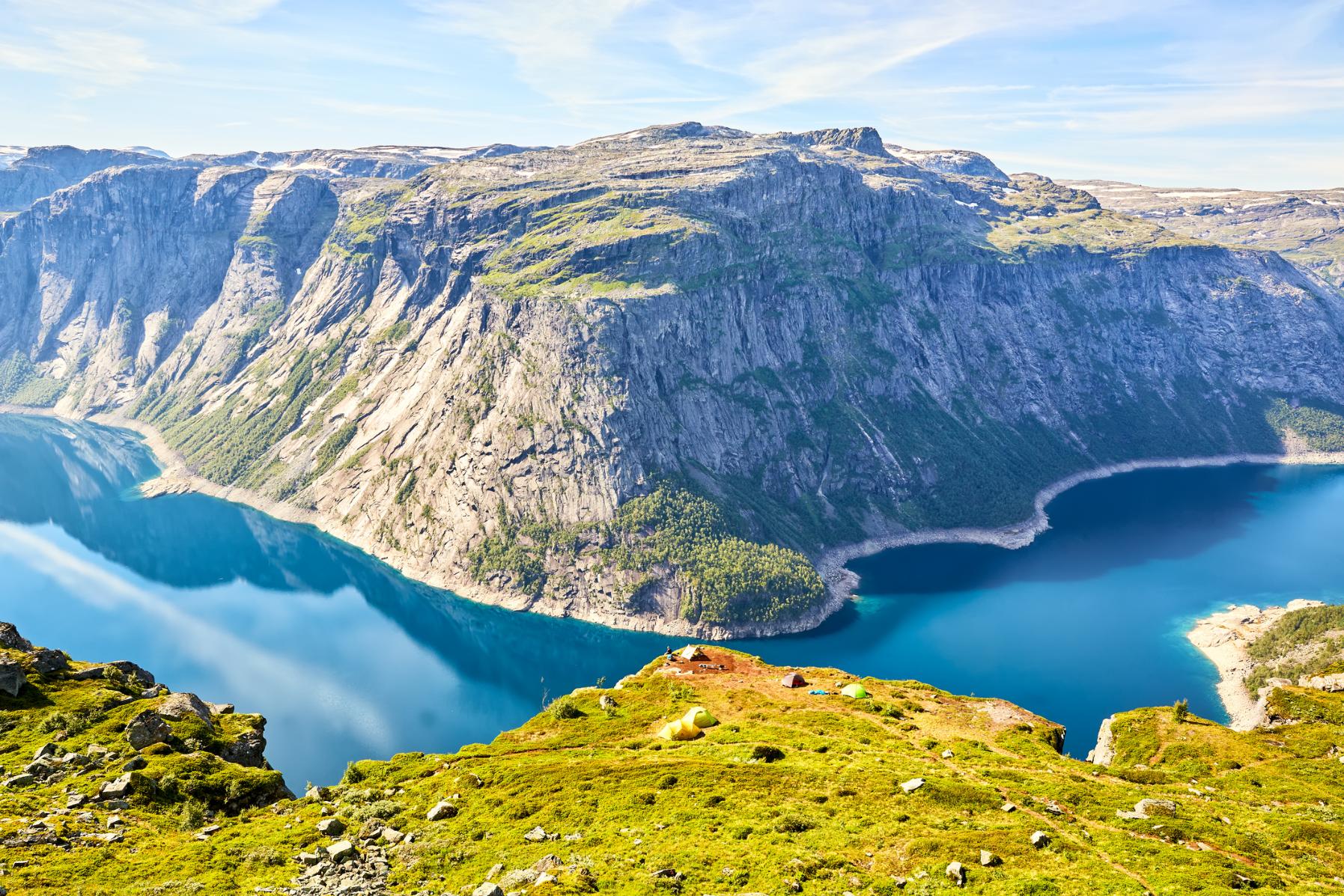
Camping is allowed along the Trolltunga route. There are designated camping areas, but wild camping is also permitted under Norway’s "allemannsretten" or ‘right to roam’ law. Ensure you camp responsibly, and leave no trace when you depart.
Alternatively, there are several small villages near Trolltunga where you can stay. Tyssedal is a mere 3.7 miles (6km) from the trailhead, perched on the shores of Ringedalsvatnet Lake, and has several aparthotels, guesthouses and dormitory style accommodation. Odda is 9.3 miles (15km) away; it’s a slightly larger town with a wider range of accommodation. You can reach Trolltunga from both towns on the shuttle bus.
How to Get to Trolltunga?
By Public Transport: The closest town to Trolltunga is Odda. From here, it’s around 9.3 miles (15km) to the trailhead. There are shuttle buses between Odda and the trailhead, which take around 30 minutes - we strongly recommend booking these in advance.
You can travel to Odda by bus from Bergen, Voss and Hardanger - the latter two can both be reached from Oslo by train.
By Car: Trolltunga is accessible by road. From Bergen, the journey takes about three hours, from Oslo six hours and from Stavanger, four hours. There are three parking areas you can use when hiking Trolltunga. P1 Tyssedal is a 23.6 mile round trip from Trolltunga, whilst P2 Skjeggedal is closer at 16.7 miles (27km). The closest car park is P3 Mågelitopp, which shortens your hike to 12.4 miles (20km). However, it only has space for 30 cars, and you must pre-book a space - they’re expensive, at 600 NOK (£42.54) for the day.
Read More:
- 10 of the Best Hikes in Norway
- 5 of the Best Winter Hikes in Norway
- 15 of the Most Beautiful Fjord Hikes in Norway
Inspired? Check out our Adventures in Norway, taking you to some of the country's most scenic locations.


